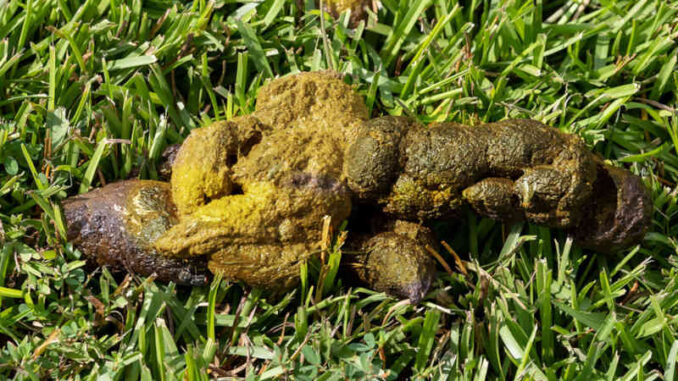
This article was updated on September 30th, 2023
Keeping an eye on your dog’s poop color and consistency can really help you spot changes in his health. One of those changes you may notice is yellow dog poop. As a veterinarian, I’ve seen dog poop in as many colors as the leaves in the fall, some more alarming than others. So, let’s dive into the causes of yellow poop and discuss 5 steps you can take at home to help your dog.

Common Causes of Yellow Poop in Dogs
Let’s look at causes for yellow dog poop:
1. Garbage Gut (Your Dog Ate Something Bad for Them)
Signs that garbage gut is affecting your dog:
- Yellow dog poop
- Poop will usually be softer or runnier than usual.
- Dogs may also have vomiting, not want to eat, and stomach pain.
Garbage gut is inflammation of the digestive tract that dogs can get from eating something they shouldn’t have, usually garbage. Rotten food or undigestibles can lead to irritation of the digestive system that causes the body to speed up digestion in order to move things out more quickly. This faster transit time can leave bile in the feces and a yellow color. Mild cases may be treated at home by giving a bland diet in small amounts for a few days, and offering lots of water. Severe cases may require fluids and other medications at the vet.
2. Gastroenteritis
Common signs:
- Yellow dog poop
- Diarrhea is usually also involved
- Dogs may also experience vomiting or fever
- Lack of appetite
Gastroenteritis just refers to inflammation of the digestive tract, either the stomach or the intestines. It can be caused by parasites, a viral or bacterial infection, or eating something they shouldn’t have. Similar to garbage gut, gastroenteritis can produce yellow dog poop due to feces passing through the intestines faster, causing increased amounts of yellow bile in the feces. Mild cases can be monitored at home with a bland diet fed in small amounts for a few days and lots of water. Cases that aren’t better within 48 hours should see a veterinarian for fluids and other medications.
3. Inflammatory Bowel Disease (IBD)
Common signs:
- Yellow dog poop that may look mucousy or slimy.
- Dogs with IBD will usually also have diarrhea and weight loss.
- They may also have stomach pain and a hit-or-miss appetite.
Inflammation in the intestines can lead to faster digestive times and incomplete digestion. Both are capable of causing yellow dog poop. IBD will need to be treated by a veterinarian as it often requires a change in diet and other medications.
4. Pancreatitis
Common signs:
- Yellow dog poop.
- Vomiting, fever, abdominal pain, diarrhea.
- Lack of energy.
Part of the pancreas’ job is to produce digestive enzymes. When it becomes inflamed, its ability to do that may be decreased. What this leads to is incomplete digestion, even including yellow dog poop. Pancreatitis can be a very serious issue that should be seen by a veterinarian. Fluids, supportive medications, and hospitalization are often required.
5. Change in Diet
A dog’s microbiome adjusts according to his diet. These beneficial bacteria change in order to efficiently digest the food they are used to. Any sudden changes in diet can throw off the balance and lead to digestive issues, including yellow dog poop. There may not by any other signs, or dogs may have some vomiting and lack of appetite to go along with softer, yellow poop. This issue will usually resolve itself within a few days. Gradually transitioning to a new food is the best way to prevent this from happening.
6. Food Intolerance
Common signs:
- Yellow dog poop that looks soft or mucousy
- Vomiting and weight loss
Dogs can develop food allergies or intolerances to certain ingredients, usually the protein source, in their dog food. When this happens, it can lead to yellow dog poop due to faster transit times or intestinal inflammation. Finding the ingredient and removing it from your dog’s diet is the best treatment.
7. Foreign Objects
It’s no secret that dogs will eat anything. Some of those things they eat won’t be digestible and will pass into the feces in a whole, or nearly whole, form. If those objects happen to be yellow, you may notice yellow dog poop. Crayons or tennis balls are two major ones. This cause will often not be uniform in color, and instead will have chunks or strings of yellow in otherwise normal-colored poop. Consistency may be normal and there may not be any other signs.
Other Causes
Less commonly, yellow dog poop may be caused by liver disease, gallbladder issues, or cancer. Any of these may show up with other signs, including vomiting, weight loss, loss of appetite, or yellowing of the skin and eyes. See your veterinarian, as none of these are treatable at home.
When is Yellow Dog Poop a Cause for Concern?
If you notice a change in your dog’s poop color, don’t be alarmed right away. Instead monitor him for other signs. If along with the yellow color, see your veterinarian if your dog is showing any of the following signs. Any of these could be an indication that something more serious is going on.
- Not wanting to eat
- Stomach pain
- Fever
- Weight loss
- Abdominal enlargement
- Severe diarrhea and vomiting
- Mild diarrhea and vomiting lasting longer than 48 hours
When is Yellow Dog Poop Not as Much of a Concern?
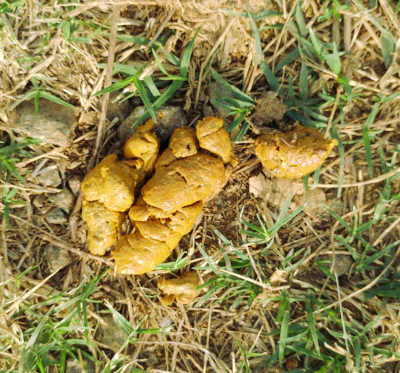
Not every yellow dog poop is going to warrant a vet visit. If this is the first time you’ve noticed a change in color and your dog is otherwise acting normal, you may choose to wait and see. Even a couple yellow poops in a row without other signs may still be okay, especially if that yellow is in the form of spots or streaks.
If your dog is showing some other signs of mild vomiting or diarrhea, you may try feeding him boiled chicken and rice for a few days. When given in small amounts more frequently, this bland diet can help give the digestive tract a break while it tries to heal whatever minor inflammation is going on (see our recommendations later in this article).
Example yellow poop: Maggie, 5 years old
Maggie ended up with the following poop at the park: a mix of regular brown with some orange / yellow colors, as shown on the image below:
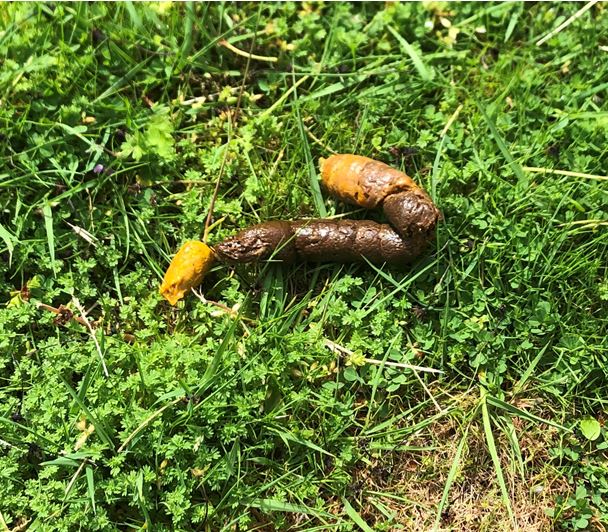
Our vet’s advice: “Here is some normally formed dog poop with some yellow color. It may also be a little mucousy. If the poop is normally formed and has some mucous it usually means some irritation to the intestine. Alert your vet if you see repeat bowel movements that look the same or if the poop becomes more like diarrhea (Vomiting, abdominal pain, weight loss and not eating may also accompany and would be a reason to call your vet).
Key take-away in this case: If you dog has more severe signs, including not eating, a fever, or stomach pain, or if that mild vomiting and diarrhea last longer than 48 hours, see your vet.
What if My Dog’s Poop is BRIGHT Yellow?
So when we say yellow, that color can range anywhere from a yellowish tinge to mustard yellow to that bright highlighter yellow. While any discoloration of poop is off-putting, seeing bright, almost fluorescent, yellow poop can be even more upsetting.
Very yellow or very bright dog poop is usually because of the presence of bile. This can indicate any of the conditions above that leads to faster digestive times, including IBD, gastroenteritis, and food intolerances. When bright yellow dog poop is coupled with yellowing of the skin and eyes, can be very indicative of a bile duct obstruction or liver issue.
If your dog isn’t showing any other signs, chances are that bright yellow dog poop is because of something they ate. Check their new foods or treats for yellow dyes or your craft supplies for missing yellow markers.
Five Steps You Can Take at Home for Yellow Dog Poop
If your dog falls into the category of mild or no other signs, at-home treatment can consist of:
1. Keep your dog hydrated
With vomiting or diarrhea, dehydration is always a concern. It’s also a good idea to keep your pup hydrated even if he’s not vomiting. Be sure to provide multiple bowls of fresh, clean water in different areas of your home so that there is always some in reach. You can also mix a little low sodium chicken broth or a tiny bit of canned food in to entice more drinking.
2. Fast your dog for 12-24 hours
If your pup is otherwise healthy, fasting him for 12-24 hours will help the body clear what digestive materials are there and get it ready for a reset. When you offer then food again, make sure it’s a bland diet in small amounts. If your dog has other health concerns, speak to your vet before fasting him.
3. Feed your dog a bland diet
When a dog’s digestive tract is inflamed, the last thing it wants to do is work hard at digesting new, incoming food. Try feeding him a bland, easily digestible diet of boiled chicken or hamburger and rice. It will provide energy without overworking his healing system.
4. Feed small meals every 3-4 hours
Divide that bland diet into several small meals fed every 3-4 hours rather than larger feedings once or twice a day. This is just another way of not overworking the digestive system and it will provide nutrients without increasing irritation.
5. Help your dog’s digestion with probiotics
Probiotics help support the good bacteria in your dog’s gut. They can help balance his digestive tract and get things working properly again. You may choose a commercial probiotic (see product below), or use a little bit of plain yogurt.
Veterinarian Tip:
“You may want to collect a fecal sample to show your vet the yellow that you are talking about. Yellow dog poop can mean a lot of different things, so the exact color of yellow as well as whether it’s uniform or spotted can give them a clue. Taking a picture will also help your vet assess the color and consistency“Dr. Chyrle Bonk, Veterinarian
SeniorTailWaggers.com
When to See Your Veterinarian
If your dog’s yellow dog poop is accompanied by more severe signs of fever, lethargy, not eating, or vomiting and diarrhea, don’t hesitate to contact your vet. Also, don’t be afraid to make an appointment any time you’re worried.
Your vet will start with a thorough exam to check for dehydration, stomach tenderness and a fever. They may run blood work to check liver and pancreas enzymes, or they may need to do an ultrasound or x-ray to look for foreign objects.
From there, the treatment will depend on the cause of your dog’s yellow poop. For garbage gut, gastroenteritis, or pancreatitis, fluids and anti-vomiting medications may be needed. Antibiotics and pain meds may be necessary as well. Severe cases may require hospitalization. Look to spend $200-$,1,000 or more depending on the severity of these issues.
IBD may require further diagnostics and a trial-and-error period of antibiotics, a high fiber diet and possibly steroids to get under control. This may cost you $300-$1,000 or more for the initial workup with lifelong medications on top of that once a proper dosage and treatment is found. If dogs respond well to treatment, they can live a fairly normal life. Other dogs will need constant changing and adjusting to manage IBD, and still others won’t respond at all.
Food allergies usually require an elimination diet or a novel protein diet to find the problem ingredient. Once that ingredient is found, it should stay out of your dog’s food bowl for life. Fortunately, there are many novel protein diets on the market, including venison, duck, buffalo, and salmon that aren’t as expensive as a hypoallergenic or limited ingredient diet that some dogs with food allergies may have to resort to.
Liver disease or gall bladder issues may require additional medications or even surgery to fix. Mild issues will usually resolve with medications, while more severe issues that require surgery are going to take longer. Very severe cases of liver disease, cancer or gall bladder disease can be fatal. Look to spend $300-$1,500 or more for these problems.
Why Did My Dog Poop Turn Yellow?
To begin with, let’s talk about why normal dog poop is brown. Bile, which is made by the liver, is released from the gall bladder as food leaves the stomach. It helps with further digestion as food moves through the intestines. Most of the bile is resorbed and recycled, which leaves a brown staining on the feces. If for some reason that bile isn’t resorbed properly, it stays with the feces, giving it its yellow color.

Learn more about dog stool colors with our dog poop color chart.
Other Tips to Know for Yellow Dog Poop
Any changes in the color or consistency of your dog’s poop should be noted, as well as any other signs they may be showing. Giving your vet all of the information that you can about the issue will better help them determine the cause and best treatment. Keep in mind that things like changes in diet, getting into the garbage or being around a new dog can all become important.
You may also want to collect a fecal sample to show your vet the yellow that you’re talking about. Yellow dog poop can mean a lot of different things, so the exact color of yellow as well as whether it’s uniform or spotted can give them a clue. A fecal sample will show your vet the consistency and odor as well and allow them to run any tests that they may need. Get the freshest sample possible.
Taking a picture of the feces is another way that you can help diagnostically. It will help your vet assess the color and consistency, however it won’t help them if they need to run tests, so gather a sample if possible.
Yellow poop & newborn puppies
When puppies are first born, they excrete what is known as meconium – a thick, sticky, greenish-black substance. As they start nursing, their stool transitions to a seedy mustard-like (yellow) color and consistency. Learn more about yellow poop in newborn puppies.
Disclaimer: This website's content is not a substitute for veterinary care. Always consult with your veterinarian for healthcare decisions. Read More.




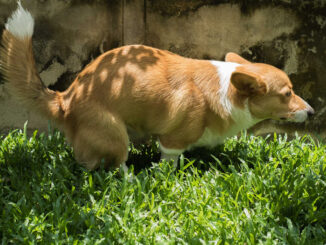
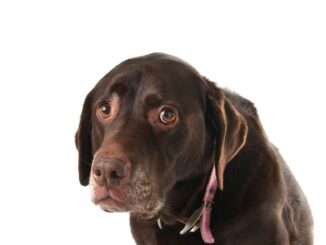
Be the first to comment